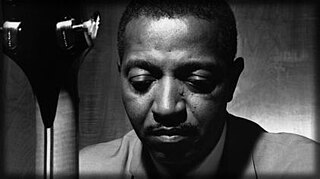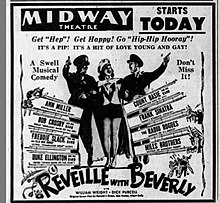
William James "Count" Basie was an American jazz pianist, organist, bandleader, and composer. In 1935, he formed the Count Basie Orchestra, and in 1936 took them to Chicago for a long engagement and their first recording. He led the group for almost 50 years, creating innovations like the use of two "split" tenor saxophones, emphasizing the rhythm section, riffing with a big band, using arrangers to broaden their sound, and others. Many musicians came to prominence under his direction, including the tenor saxophonists Lester Young and Herschel Evans, the guitarist Freddie Green, trumpeters Buck Clayton and Harry "Sweets" Edison, plunger trombonist Al Grey, and singers Jimmy Rushing, Helen Humes, Thelma Carpenter, and Joe Williams.
The 1st Annual Grammy Awards were held on May 4, 1959. They recognized musical accomplishments by performers for the year 1958. Two separate ceremonies were held simultaneously on the same day; the first hotel in Beverly Hills, California, and the second in the Park Sheraton Hotel in New York City. Ella Fitzgerald, Count Basie, Domenico Modugno, Ross Bagdasarian, and Henry Mancini, each won 2 awards.

Ella Mae Morse was an American singer of popular music whose 1940s and 1950s recordings mixing jazz, blues, and country styles influenced the development of rock and roll. Her 1942 recording of "Cow-Cow Boogie" with Freddie Slack and His Orchestra gave Capitol Records its first gold record. In 1943, her single "Get On Board, Little Chillun", also with Slack, charted in what would soon become the R&B charts, making her one of the first white singers to do so. Morse stopped recording in 1957 but continued to perform and tour into the 1990s. In 1960 she received a star on the Hollywood Walk of Fame.

Frederick Charles Slack was an American swing and boogie-woogie pianist and bandleader.

Harry "Sweets" Edison was an American jazz trumpeter and a member of the Count Basie Orchestra. His most important contribution was as a Hollywood studio musician, whose muted trumpet can be heard backing singers, most notably Frank Sinatra.
The swing era was the period (1933–1947) when big band swing music was the most popular music in the United States. Though this was its most popular period, the music had actually been around since the late 1920s and early 1930s, being played by black bands led by such artists as Duke Ellington, Jimmie Lunceford, Bennie Moten, Cab Calloway, Earl Hines, and Fletcher Henderson, and white bands from the 1920s led by the likes of Jean Goldkette, Russ Morgan and Isham Jones. An early milestone in the era was from "the King of Swing" Benny Goodman's performance at the Palomar Ballroom in Los Angeles on August 21, 1935, bringing the music to the rest of the country. The 1930s also became the era of other great soloists: the tenor saxophonists Coleman Hawkins, Ben Webster and Lester Young; the alto saxophonists Benny Carter and Johnny Hodges; the drummers Chick Webb, Gene Krupa, Jo Jones and Sid Catlett; the pianists Fats Waller and Teddy Wilson; the trumpeters Louis Armstrong, Roy Eldridge, Bunny Berigan, and Rex Stewart.
"Take the 'A' Train" is a jazz standard by Billy Strayhorn that was the signature tune of the Duke Ellington orchestra.

Mary Elizabeth Roché was an American blues and jazz singer. Though she had a sporadic career, she became best known for her version of "Take the 'A' Train" with Duke Ellington, and, according to AllMusic, "was famous for her strong, dramatic way of putting across blues material".
"Mr. Five by Five" is a 1942 popular song by Don Raye and Gene DePaul, that describes a heavyset man who is "five feet tall and five feet wide". The person highlighted by the song was Jimmy Rushing, the featured vocalist of Count Basie's Orchestra from 1935 to 1948.
"I'm Gonna Sit Right Down and Write Myself a Letter" is a 1935 popular song with music by Fred E. Ahlert and lyrics by Joe Young. It has been recorded many times, and has become a standard of the Great American Songbook. It was popularized by Fats Waller, who recorded it in 1935 at the height of his fame.

The Count Basie Orchestra is a 16- to 18-piece big band, one of the most prominent jazz performing groups of the swing era, founded by Count Basie in 1935 and recording regularly from 1936. Despite a brief disbandment at the beginning of the 1950s, the band survived long past the big band era itself and the death of Basie in 1984. It continues under the direction of trumpeter Scotty Barnhart.

Frederick William Green was an American swing jazz guitarist who played rhythm guitar with the Count Basie Orchestra for almost fifty years.
Charles Baker Fowlkes was an American baritone saxophonist who was a member of the Count Basie Orchestra for over twenty-five years.
"I'm Beginning to See the Light" is a popular song and jazz standard, with music written by Duke Ellington, Johnny Hodges, and Harry James and lyrics by Don George and published in 1944.
"I Didn't Know About You" is a song composed by Duke Ellington, with lyrics written by Bob Russell. Recorded in 1944 with vocal by Joya Sherrill, it was based on an instrumental first recorded by Ellington in 1942 under the title "Sentimental Lady".
"In a Mellow Tone", also known as "In a Mellotone", is a 1939 jazz standard composed by Duke Ellington, with lyrics written by Milt Gabler. The song was based on the 1917 standard "Rose Room" by Art Hickman and Harry Williams, which Ellington himself had recorded in 1932. Howard Stern used a recording of this song as the opening theme to The Howard Stern Show from 1987 to 1994.
"Cow Cow Boogie (Cuma-Ti-Yi-Yi-Ay)" is a "country-boogie"-style blues song, with music was written by Don Raye, and lyrics were written by Benny Carter and Gene De Paul. The song was written for the 1942 Abbott & Costello film Ride 'Em Cowboy, which included Ella Fitzgerald as a cast member, but was cut from the movie.

Swing jazz emerged as a dominant form in American music, in which some virtuoso soloists became as famous as the band leaders. Key figures in developing the "big" jazz band included bandleaders and arrangers Count Basie, Cab Calloway, Jimmy and Tommy Dorsey, Duke Ellington, Benny Goodman, Fletcher Henderson, Earl Hines, Glenn Miller, and Artie Shaw. Duke Ellington and his band members composed numerous swing era hits that have become standards: "It Don't Mean a Thing " (1932), "Sophisticated Lady" (1933) and "Caravan" (1936), among others. Other influential bandleaders of this period were Benny Goodman and Count Basie.
"I Can't Believe That You're in Love with Me" is a 1926 popular song and jazz standard composed by Jimmy McHugh, with lyrics by Clarence Gaskill.








